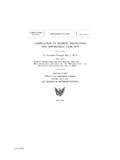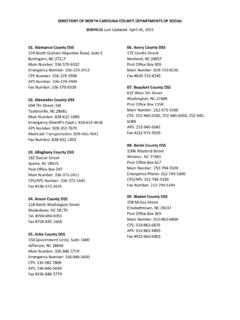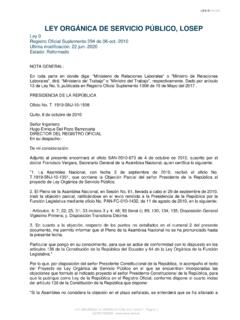Transcription of E 11 Clinical Investigation of Medicinal Products in the ...
1 European Medicines Agency 7 Westferry Circus, Canary Wharf, London, E14 4HB, UK Tel. (44-20) 74 18 85 75 Fax (44-20) 75 23 70 40 E-mail: EMEA 2006 Reproduction and/or distribution of this document is authorised for non commercial purposes only provided the EMEA is acknowledged January 2001 CPMP/ICH/2711/99 ICH Topic E 11 Clinical Investigation of Medicinal Products in the Paediatric Population Step 5 NOTE FOR GUIDANCE ON Clinical Investigation OF Medicinal Products IN THE PAEDIATRIC POPULATION (CPMP/ICH/2711/99) TRANSMISSION TO CPMP October 1999 RELEASE FOR CONSULTATION October 1999 DEADLINE FOR COMMENTS April 2000 FINAL APPROVAL BY CPMP July 2000 DATE FOR COMING INTO OPERATION January 2001 EMEA 2006 2 Clinical Investigation OF Medicinal Products IN THE PAEDIATRIC POPULATION 1.
2 Objectives of the guidance ..3 Background ..3 Scope of the guidance ..3 General 2. GUIDANCE ..4 Issues when initiating a pediatric Medicinal product development program ..4 Pediatric Timing of Medicinal Products for diseases predominantly or exclusively affecting pediatric patients ..5 Medicinal Products intended to treat serious or life-threatening diseases, occurring in both adults and pediatric patients, for which there are currently no or limited therapeutic Medicinal Products intended to treat other diseases and conditions.
3 5 Types of studies ..6 Efficacy ..8 Postmarketing Age classification of pediatric patients ..9 Preterm newborn infants ..9 Term newborn infants (0 to 27 days) ..10 Infants and toddlers (28 days to 23 months) ..10 Children (2 to 11 years) ..10 Adolescents (12 to 16-18 years (dependent on region)) ..11 Ethical issues in pediatric studies ..11 Institutional Review Board/Independent Ethics Committee (IRB/IEC)..11 Consent and assent ..12 Minimizing risk ..12 Minimizing EMEA 2006 3 1. INTRODUCTION Objectives of the guidance The number of Medicinal Products currently labeled for pediatric use is limited.
4 It is the goal of this guidance to encourage and facilitate timely pediatric Medicinal product development internationally. The guidance provides an outline of critical issues in pediatric drug development and approaches to the safe, efficient, and ethical study of Medicinal Products in the pediatric population. Background Other ICH documents with relevant information impacting on pediatric studies include: E2: Clinical Safety Data Management E3: Structure and Content of Clinical Study Reports E4: Dose-Response Information to Support Drug Registration E5: Ethnic Factors in the Acceptability of Foreign Clinical Data E6: Good Clinical Practice: Consolidated Guideline E8: General Considerations for Clinical Trials E9: Statistical Principles for Clinical Trials E10: Choice of Control Group in Clinical Trials M3.
5 Nonclinical Safety Studies for the Conduct of Human Clinical Trials for Pharmaceuticals Q1: Stability Testing Q2: Validation of Analytical Procedures Q3: Impurity Testing Scope of the guidance Specific Clinical study issues addressed include: (1) considerations when initiating a pediatric program for a Medicinal product; (2) timing of initiation of pediatric studies during Medicinal product development; (3) types of studies (pharmacokinetic, pharmacokinetic/pharmacodynamic (PK/PD), efficacy, safety); (4) age categories; and (5) ethics of pediatric Clinical Investigation .
6 This guidance is not intended to be comprehensive; other ICH guidance, as well as documents from regional regulatory authorities and pediatric societies, provide additional detail. General principles Pediatric patients should be given medicines that have been appropriately evaluated for their use. Safe and effective pharmacotherapy in pediatric patients requires the timely development of information on the proper use of Medicinal Products in pediatric patients of various ages and, often, the development of pediatric formulations of those Products .
7 Advances in formulation chemistry and in pediatric study design will help facilitate the development of Medicinal Products for pediatric use. Drug development programs should usually include the pediatric patient population when a product is being developed for a disease or condition in adults and it is anticipated the product will be used in the pediatric population. Obtaining knowledge of the effects of Medicinal Products in pediatric patients is an important goal. However, this should be done without compromising the well-being of pediatric patients participating in Clinical studies.
8 This responsibility is shared by companies, regulatory authorities, health professionals, and society as a whole. EMEA 2006 4 2. GUIDANCE Issues when initiating a pediatric Medicinal product development program Data on the appropriate use of Medicinal Products in the pediatric population should be generated unless the use of a specific Medicinal product in pediatric patients is clearly inappropriate. The timing of initiation of Clinical studies in relation to studies conducted in adults, which may be influenced by regional public health and medical needs, is discussed in section Justification for the timing and the approach to the Clinical program needs to be clearly addressed with regulatory authorities at an early stage and then periodically during the Medicinal product development process.
9 The pediatric development program should not delay completion of adult studies and availability of a Medicinal product for adults. The decision to proceed with a pediatric development program for a Medicinal product, and the nature of that program, involve consideration of many factors, including: the prevalence of the condition to be treated in the pediatric population the seriousness of the condition to be treated the availability and suitability of alternative treatments for the condition in the pediatric population, including the efficacy and the adverse event profile (including any unique pediatric safety issues)
10 Of those treatments whether the Medicinal product is novel or one of a class of compounds with known properties whether there are unique pediatric indications for the Medicinal product the need for the development of pediatric-specific endpoints the age ranges of pediatric patients likely to be treated with the Medicinal product unique pediatric (developmental) safety concerns with the Medicinal product, including any nonclinical safety issues potential need for pediatric formulation development Of these factors, the most important is the presence of a serious or life-threatening disease for which the Medicinal product represents a potentially important advance in therapy.















